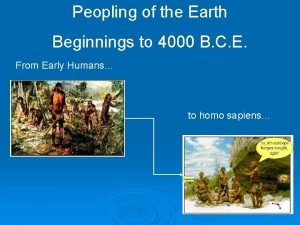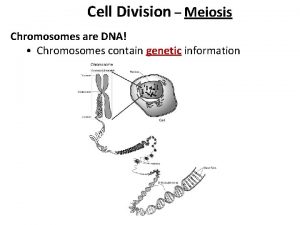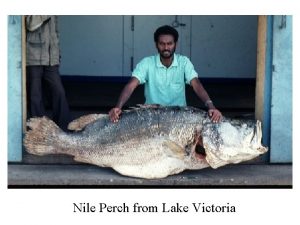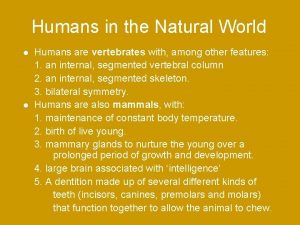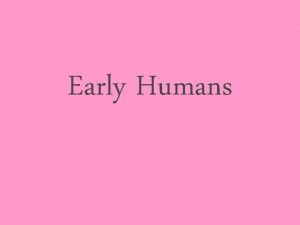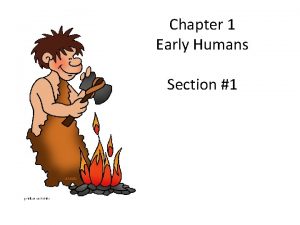ORIGIN OF MODERN HUMANS ORIGIN OF MODERN HUMANS




















- Slides: 20

ORIGIN OF MODERN HUMANS

ORIGIN OF MODERN HUMANS • First remains found in 1868 in limestone cave – Cro-Magnon cave in Southern France

ORIGIN OF MODERN HUMANS • First remains found in 1868 in limestone cave – Cro-Magnon cave in Southern France • Dated around 40’ 000 years however older have been found in Africa

ORIGIN OF MODERN HUMANS • First remains found in 1868 in limestone cave – Cro-Magnon cave in Southern France • Dated around 40’ 000 years however older have been found in Africa • Some found have been dated at 90 -120’ 000 years old = when Neanderthals were dominant. This indicates that Neanderthals could not be our ancestors.

PHYSICAL CHARACTERISTICS • Main difference between modern humans and Neanderthals – in the skull.

PHYSICAL CHARACTERISTICS • Main difference between modern humans and Neanderthals – in the skull. • Smaller brow ridges (if there at all), large, steep forehead, no ‘bun’ at the rear of the skull.

PHYSICAL CHARACTERISTICS • Main difference between modern humans and Neanderthals – in the skull. • Smaller brow ridges (if there at all), large, steep forehead, no ‘bun’ at the rear of the skull. • Prominent chin, jaws and teeth are less robust.

PHYSICAL CHARACTERISTICS • Main difference between modern humans and Neanderthals – in the skull. • Smaller brow ridges (if there at all), large, steep forehead, no ‘bun’ at the rear of the skull. • Prominent chin, jaws and teeth are less robust. • More slender limbs indicating technology was replacing Neaderthal muscle.

• https: //www. youtube. com/watch? v=PP 94 gmr. Icd. Y

TOOL TECHNOLOGY OF MODERN HUMANS • Stone tools – more finely made, more cutting edge per amount of stone used.

TOOL TECHNOLOGY OF MODERN HUMANS • Stone tools – more finely made, more cutting edge per amount of stone used. • Used bone, antler and ivory – tough and durable, able to be carved into perforations = made bone needles and fish hooks possible.

TOOL TECHNOLOGY OF MODERN HUMANS • Stone tools – more finely made, more cutting edge per amount of stone used. • Used bone, antler and ivory – tough and durable, able to be carved into perforations = made bone needles and fish hooks possible. • Combined two kinds of material to make composite tools.

TOOL TECHNOLOGY OF MODERN HUMANS • Stone tools – more finely made, more cutting edge per amount of stone used. • Used bone, antler and ivory – tough and durable, able to be carved into perforations = made bone needles and fish hooks possible. • Combined two kinds of material to make composite tools. • Tools were made for the purpose of making other tools.

HUNTING TECHNIQUES • Highly efficient hunters – woolly mammoth and other large mammals became extinct around 30’ 000 years ago.

HUNTING TECHNIQUES • Highly efficient hunters – wooly mammoth and other large mammals became extinct around 30’ 000 years ago. • Eg – bones of thousands of horses have been found at the bottom of a cliff = suggests being stampeded.

IMPROVEMENTS IN FIRE USE • Discovered how to light fire by striking sparks off iron pyrites. Earliest known ‘firestone’ found in Belgium – found along remains dated 15’ 000 years old.

IMPROVEMENTS IN FIRE USE • Discovered how to light fire by striking sparks off iron pyrites. Earliest known ‘firestone’ found in Belgium – found along remains dated 15’ 000 years old. • Learnt how to create draughts of air for the fire – increasing the temp and possibility of baking clay.

PALAEOLITHIC ART • https: //www. youtube. com/watch? v=Un. Sq 0 c 7 j. M-A • Enormous increase of satisfying emotional needs as well as physical needs

PALAEOLITHIC ART • https: //www. youtube. com/watch? v=Un. Sq 0 c 7 j. M-A • Enormous increase of satisfying emotional needs as well as physical needs • Shown by cave painting, carved statuettes, beads and ornaments

PALAEOLITHIC ART • https: //www. youtube. com/watch? v=Un. Sq 0 c 7 j. M-A • Enormous increase of satisfying emotional needs as well as physical needs • Shown by cave painting, carved statuettes, beads and ornaments • Most pictures depict horses, deer, oxen, bison, and mammoth – all important animals – dated between 15’ 000 and 30’ 000 years ago
 Chapter 22 origin of modern astronomy
Chapter 22 origin of modern astronomy Chapter 22.2 origin of modern astronomy answer key
Chapter 22.2 origin of modern astronomy answer key Diagrammatic sectional view of ovary
Diagrammatic sectional view of ovary A hypothetical population of 10 000 humans has 6840
A hypothetical population of 10 000 humans has 6840 Peopling of the earth
Peopling of the earth Chapter 6 humans in the biosphere
Chapter 6 humans in the biosphere How many chromosomes do humans have
How many chromosomes do humans have Dominic jordan
Dominic jordan Crossing over in meiosis and mitosis
Crossing over in meiosis and mitosis Chapter 6 humans in the biosphere
Chapter 6 humans in the biosphere Privet shrubs and humans each have a diploid number of 46
Privet shrubs and humans each have a diploid number of 46 What is lytta virus
What is lytta virus Homohabili brain size
Homohabili brain size Humans belong to which kingdom
Humans belong to which kingdom Personification about school supplies
Personification about school supplies How do humans affect the water cycle
How do humans affect the water cycle Karyotype
Karyotype Amish inbreeding
Amish inbreeding Can seahorses kill humans
Can seahorses kill humans Digestive system digram
Digestive system digram Where in the female reproductive system does meiosis occur
Where in the female reproductive system does meiosis occur




